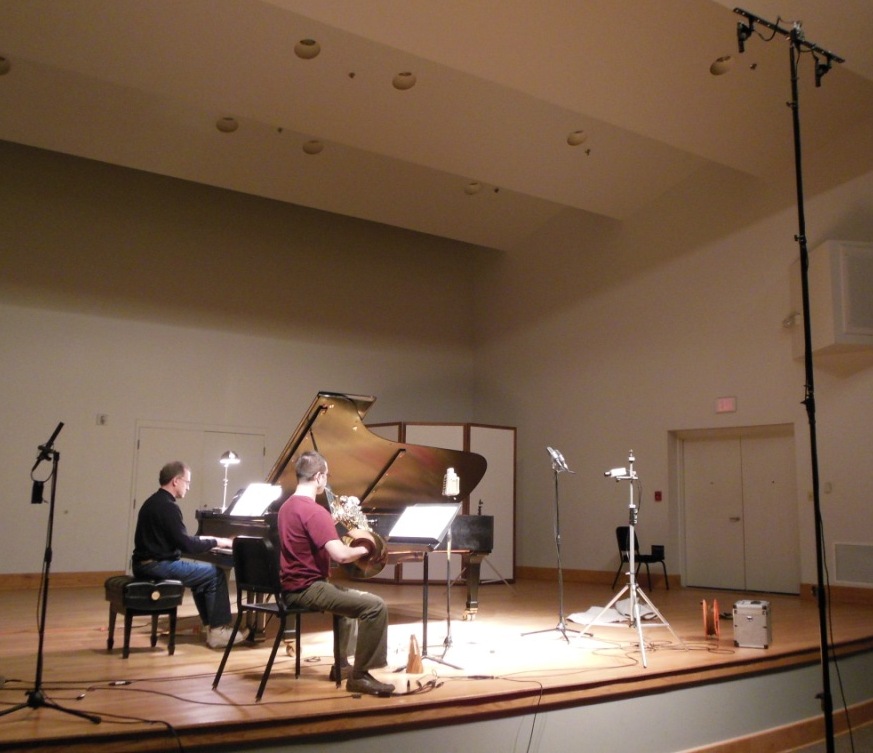Adding to this series of posts about recording sessions (Part 1, Part 2), here are some random ideas gleaned from my experiences this week. On Monday, Tuesday, and Wednesday I spent the majority of each day recording several works for horn with other instruments by Jan Koetsier. These pieces, along with a few works recorded earlier this year, will be featured on a forthcoming CD recording on the MSR Classics label. The sessions went very well, thanks in large part to the work of engineer/producer Rich Mays of Sonare Recordings, and my wonderful collaborators, Richard Seiler on piano and Jaymee Haefner on harp. Now that the recording phase of this project is completed, I can reflect on the preparation that went into it, as well as the lessons I’ve learned throughout the process.
- Prepare, Prepare, Prepare! I knew from previous experiences that recording sessions were mentally and physically draining, and as a result I spent much of the semester gearing up for three consecutive days of recording on some challenging music. Gradually increasing practice time over the course of several weeks helped to build long-term endurance, and practicing long tones helped to solidify attacks at all dynamic levels throughout the range of the instrument. Scheduling a recital of the same pieces within a month of the recording session was a great way to make sure everything stayed fresh musically and technically. In addition to the musical and physical preparation, there were also numerous logistical considerations, such as preparing the venue (the recital hall at my university) for recording. The HVAC system and other electrical systems in the hall needed to be shut down for the duration of the sessions to minimize extraneous noise, which required advance planning and collaboration with the staff of the university’s physical plant. The sessions were scheduled for a period of time after students had departed, but while the university was still open before the holiday break.
- Be Flexible: Despite your best planning, unexpected issues will crop up in every recording session. From scheduling delays to equipment (or instrument) malfunctions, it may at times seem like you aren’t accomplishing much. Try as best you can to handle each issue as it comes up without stressing out too much. Our Monday morning session started later than I had planned because the noise from a water fountain near the green room was bleeding over into the hall. A maintenance person had to be called to come disconnect the compressor before recording could begin. One of the best things I did was to not bring a watch into the sessions. For me it was better not to worry about how much time I was eating up on the clock, and instead to focus on producing as musically convincing a product as possible. If I wanted to take a break at a specific time I asked the engineer to let me know. Speaking of breaks, I recommend taking a short break at least every hour, and more frequently if necessary. As it was, we frequently went to the control room to listen to playback, so that provided several breaks along the way. In addition, I also found it refreshing to walk outside or even walk around the building every couple of hours to keep from going stir-crazy.
- Be Mindful of Preconceptions: After years of performing in our recital hall, I thought I knew what would provide the best sound for a horn and piano combination. In the end, however, we went with a radically different setup than I normally use for live performances. My technical knowledge is limited, but it had to do with microphone placement and trying to maximize the sound of the hall for recording purposes. After a bit of experimentation, we went with the following placement for horn and piano.

Notice that there are five separate microphones: a ribbon microphone for the horn, two microphones for the piano, and two microphones on a tall stand for the ensemble. We also made use of an intercom system to communicate with the control room. While the placement and spacing between the horn and piano would look a little bizarre for a live performance, it resulted in the desired effect for the recording. That being said, I really liked the overall sound, and I might try a modified version of this configuration for future performances in this hall.
- Other Observations: One interesting thing I noticed about my approach to recording sessions was that I tended to play it very safe on the first take of a passage. This first take was usually pretty accurate, but also boring! It wasn’t until the third or fourth take that I hit my stride musically and started to really go for phrases and stylistic nuances. Why didn’t I just do this on the first take and save myself some time? I think knowing that we had at least one accurate take “in the can” gave me the confidence and freedom to take chances in subsequent repetitions. I don’t perform this way live, and if anything I probably take too many chances on occasion and sacrifice accuracy. Has anyone else had a similar experience in a recording session?
There are lots of other details I could discuss, but this just about sums it up in terms of the overall experience. I am very glad to have this phase finished, and am eagerly anticipating the editing and production phase! More updates to come.

Great to see the setup and looking forward to hearing the final recording. For my two CDs the setup was similar except that I was even further out from the pianist, the bell even more toward the audience. Sound wise it was the best for the recording in our hall, and while the pianist could not see me at all when I was playing, I could see their hands easily for purposes of ensemble.
LikeLike
Thanks John!
LikeLike